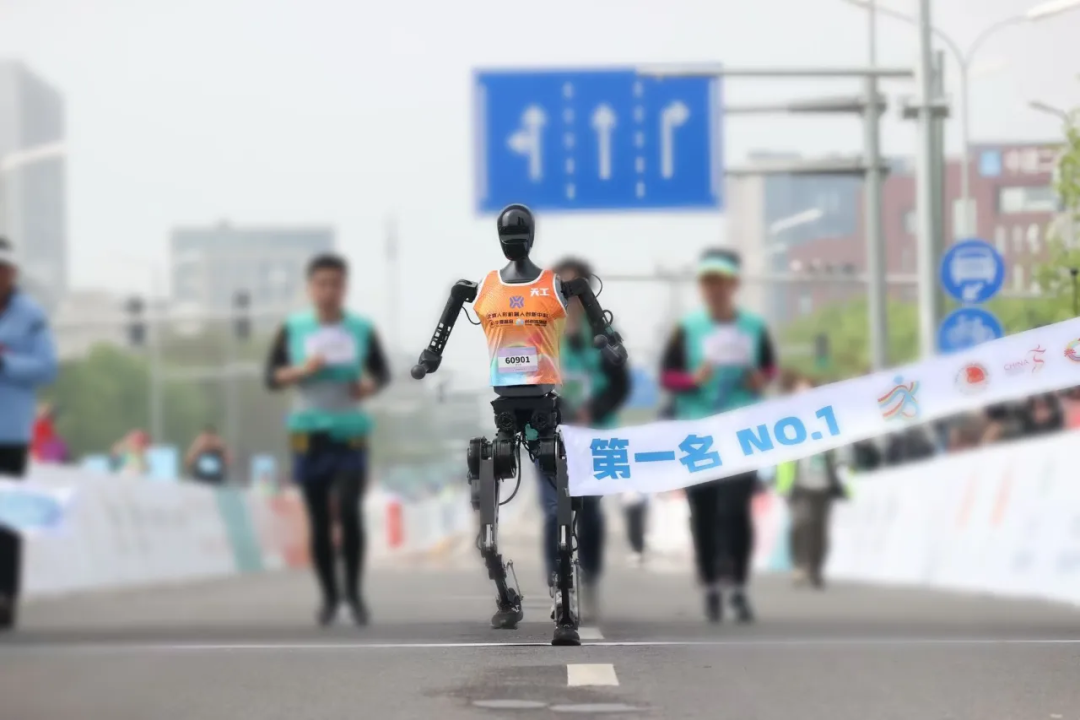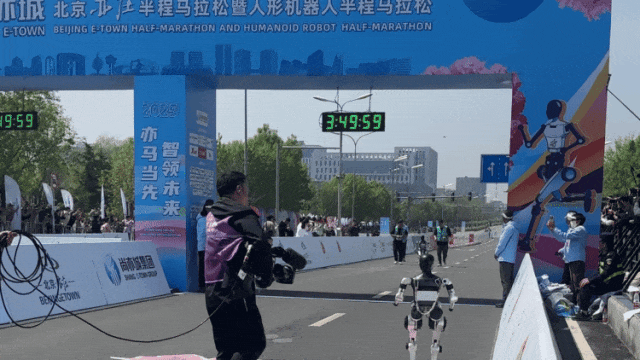On April 19, the world’s first humanoid robot half marathon held in Beijing attracted significant attention. In this feast of technology and sports, the “Tiangong Ultra” robot led the race, finishing with a time of 2 hours, 40 minutes, and 42 seconds, claiming the championship. The “N2” robot and the “Xingzhe No. 2” robot also performed excellently, securing second and third places, respectively.
According to reports, more than 20 robots participated in the half marathon, many of which had their entire systems or components produced in Jiangsu, showcasing a strong Jiangsu presence. Notably, the champion “Tiangong Ultra” and the silver medalist “N2” are both based in Wuxi and Changzhou, while the jumping humanoid robot “Kuafu” hails from Suzhou. This has drawn market attention to Jiangsu’s humanoid robot manufacturing industry.
Champion, runner-up, and third-place robot companies are all based in Su, Xi, and Changzhou
As the champion of the world’s first humanoid robot half marathon, the “Tiangong Ultra” robot was developed by UBTECH Robotics Corp. (hereinafter referred to as “UBTECH”). The organization is based at the Beijing Humanoid Robot Innovation Center. This robot stands 1.8 meters tall and can run steadily at a speed of 10 kilometers per hour.

Image source: UBTECH official WeChat account
It has been reported that UBTECH has deep ties with Wuxi. As early as 2020, Wuxi Tianqi Co., Ltd. and UBTECH jointly established Wuxi UBTECH Intelligent Technology Co., Ltd. (hereinafter referred to as “UBTECH Intelligent”); subsequently, in 2021, UBTECH Intelligent settled in the Wuxi Economic Development Zone. In 2023, the Wuxi Economic Development Zone signed a strategic cooperation agreement with UBTECH, establishing a research and development and production headquarters for industrial-grade robots and outdoor L4-level unmanned logistics vehicles. In 2024, the construction of the UBTECH Industrial Embodied Intelligent Robot Industrial Park and UBTECH Intelligent headquarters project will commence, with production expected to start by the end of June 2026.
The runner-up “N2” robot was developed by Songyan Power (Beijing) Technology Co., Ltd. (hereinafter referred to as “Songyan Power”). It resembles a nimble little sprite, standing 1.2 meters tall, weighing 30 kilograms, and equipped with 18 high-performance joints and an advanced motion control system, allowing it to maintain stability and agility while running at high speeds.

Image source: Songyan Power official WeChat account
In this half marathon, Songyan Power had two teams participating—the Little Rascal Team and the Whirlwind Team, with both teams using the “Songyan Power N2” robot. Ultimately, the two teams finished second and third, respectively.
“In this competition, the performance of the two teams of robots was not just a demonstration of technology but also validated their reliability in real-world scenarios,” a representative from Songyan Power stated in an interview after the race. “In the future, the company will continue to promote technological innovation and explore more application scenarios.”
According to reports, Songyan Power has reached a project cooperation agreement with the Tian Ning Economic Development Zone in Changzhou to promote the industrialization of humanoid robots and establish a local automotive parts industrial park.
Additionally, the “Kuafu” humanoid robot from Suzhou attracted considerable attention during this half marathon. Developed by Leju Robotics, it stands 1.7 meters tall and is the first domestically produced open-source HarmonyOS humanoid robot capable of jumping and adapting to multiple terrains, with a running speed exceeding 7 kilometers per hour.
Leju Robotics settled in Wujiang District, Suzhou in 2022. Since its establishment in Suzhou, Leju Robotics has successively launched hospital logistics robots, high-dynamic humanoid robots, and other research achievements, completing mass deliveries in three major scenarios: industrial manufacturing, commercial services, and scientific education. On December 26, 2024, Leju Robotics will launch the province’s first humanoid robot production line located in the Dongtai Lake Resort area, with an expected annual production of 200 humanoid robots. In January of this year, the company delivered its 100th full-size humanoid robot.
Yuan Shuai, an expert from the China Urban Development Research Institute, stated in an interview that different cities in Jiangsu exhibit differentiated positioning in their robot industry layouts. Changzhou focuses on “robotics + artificial intelligence” as its core, forming a robot industry cluster centered in Wujin District, with a focus on developing industrial robots, service robots, and establishing technological advantages in machine vision and smart healthcare. Wuxi is associated with UBTECH and other companies, laying out in cutting-edge fields such as embodied intelligence and humanoid robots, promoting the application of robot technology in industrial manufacturing and service consumption. Suzhou, through projects like Leju Robotics’ “Kuafu,” is making strides in artificial intelligence and humanoid robots, aiming to build a complete robot industry chain and ecosystem.
Jiangsu Presses the “Accelerate Button” on Robot Industry Layout
Embodied intelligence is undoubtedly one of the hottest areas for technology investment today. The 2025 government work report clearly states the need to cultivate future industries such as embodied intelligence, pointing the way for the development of this field.
Jiangsu has unique advantages in the field of embodied intelligence. “From the perspective of the industrial chain, Jiangsu has significant advantages in core components such as servo motors and sensors, as well as in system integration and scenario applications,” Yuan Shuai explained to reporters. “Jiangsu has a strong manufacturing base, forming a complete industrial chain from key materials to core components, and then to complete machine manufacturing and system integration, all possessing strong competitiveness. In terms of scenario applications, Jiangsu actively promotes the application of robot technology in industrial manufacturing, healthcare, and elderly care services, creating a rich array of application scenarios and market demand.”
For example, in Suzhou, there are currently over 600 companies related to the robot industry chain, with 273 large-scale industrial enterprises, and the industry scale is expected to reach 139.5 billion yuan by 2024. In the primary market, investment and financing activities in the field of embodied intelligence are also very active. In 2024, Suzhou’s Wuzhong District announced the establishment of a robot industry investment fund with a total scale of 10 billion yuan. With the dual push of capital and talent, the embodied intelligence industry ecosystem in Suzhou is further improving, and its development momentum is becoming increasingly strong.
Changzhou is an important domestic hub for the robot industry, with the production of industrial robot bodies accounting for nearly a quarter of the national total, and collaborative robot production leading the nation, housing nearly 150 companies in the robot industry chain, including Nabtesco, Yaskawa Robotics, and Qianjing Rehabilitation. In 2024, Changzhou achieved an output value of 30.9 billion yuan, covering a complete industrial chain from “key components” to “complete machine production” to “system integration.”
In 2024, Changzhou formulated a “Three-Year Action Plan for Leapfrog Development of the Robot Industry,” outlining a roadmap for accelerating the large-scale, high-end, and intelligent development of the robot industry. “Next, we will accelerate the layout of high-end complete machines, control systems, and robot power batteries, strengthen the attraction of core component projects such as reducers, sensors, and servo motors, and promote the development of emerging fields such as humanoid robots, educational robots, and medical robots,” said Han Xueqin, Secretary of the Party Leadership Group and Director of the Changzhou Bureau of Commerce.
Recently, Wuxi also released the “Implementation Plan for the Development of the Embodied Intelligent Robot Industry in Wuxi (2025-2027),” aiming for an industry scale exceeding 30 billion yuan in three years and increasing the number of industrial cluster enterprises to 200, creating no less than 300 typical application scenarios. Suzhou has proposed that by 2027, a preliminary innovation development system for the embodied intelligent robot industry will be established, supporting the robot industry scale to reach 200 billion yuan. In the next 3 to 5 years, Jiangsu’s robot industry is expected to form a global influence in high-end manufacturing, service robots, and humanoid robots in various sub-sectors.
Experts indicate that embodied intelligence is not only a technological innovation but also a transformation of production methods. With the comprehensive advantages of “manufacturing foundation + innovative policies + open scenarios,” Jiangsu is expected to “lead the way and set an example” in the future industry of embodied intelligence, writing a new chapter in technology for a “strong, prosperous, beautiful, and high” Jiangsu.
Authors: Qiu Siyu, Zhong Qian
